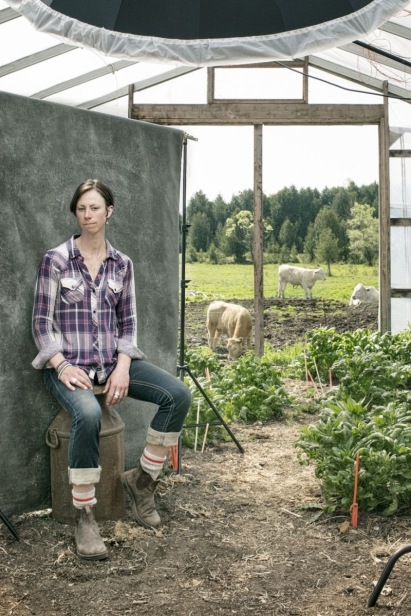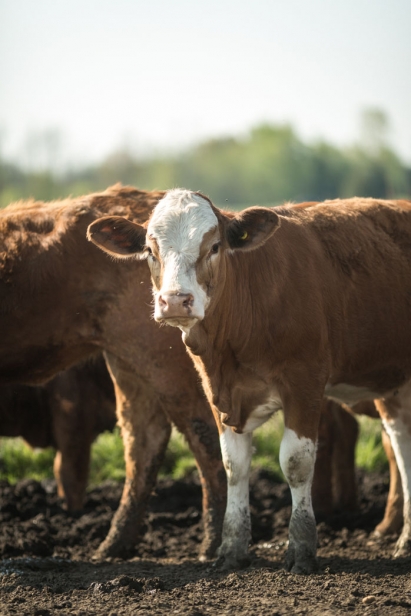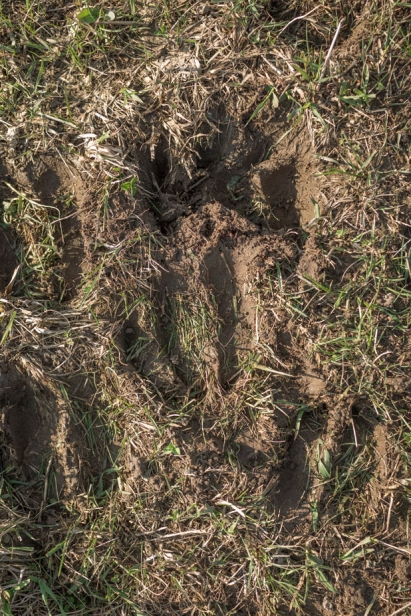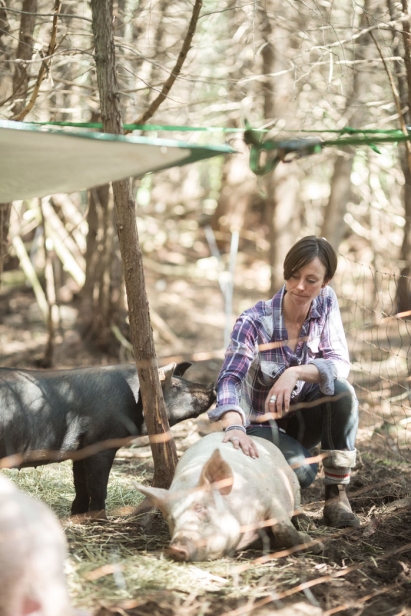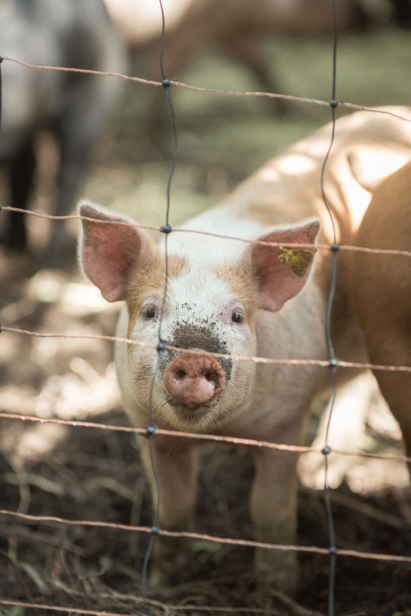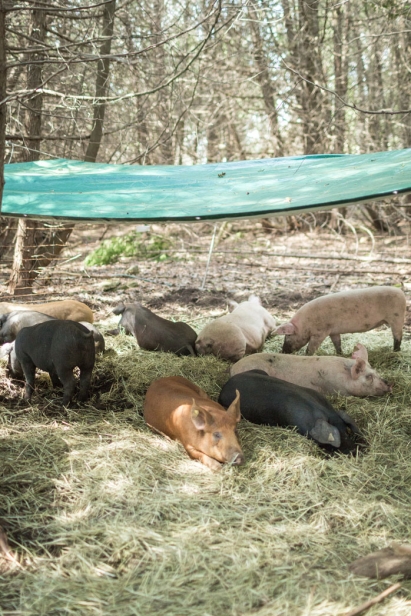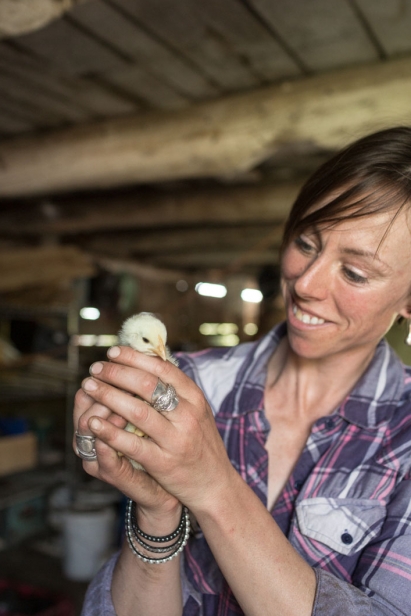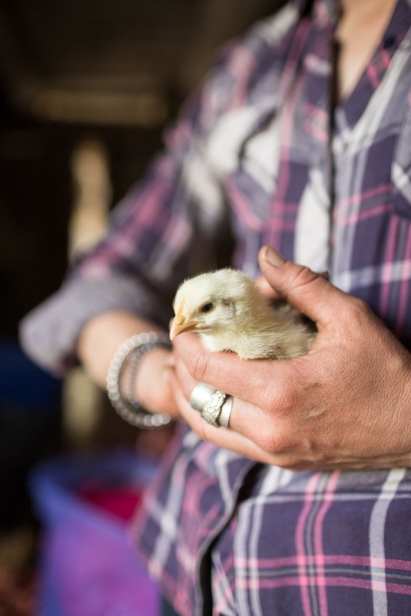The Big Picture - Amber Payne
At Arc Acres farm, a herd of ruddy-haired bovines clearly have the spotlight. It’s easy to see why — the lumbering beasts are the main source of Amber Payne’s livelihood, providing the farmer’s dedicated CSA followers and market-goers with succulent and flavourful cuts of grass-fed Red Angus beef from her family farm in Greely, Ont. But for Payne, it’s a much smaller and less revered creature working diligently behind the scenes that she feels deserves some, if not equal, attention.
“My dung beetle population is booming,” she says proudly. “The poop pile from last year is totally gone.”
Many of us have only witnessed the curious and somewhat comical dung beetle manoeuvring tightly packed balls of excreta on nature documentaries about the African plains, but the armour-clad scarabs have made their home just about everywhere. From forest floors to sand dunes, wherever animals are doing their odoriferous business, dung beetles are there to clean up the mess. They collect waste and roll it into balls, sometimes up to 10 times their own size and bury them into small burrows that they bore into the ground. This naturally aerates the land enabling water to enter the channel, while packing it with nutrient-dense nuggets of fertilizer. Their presence is especially beneficial on farmland where waste collects en masse, but only if the industrious critters don’t succumb to the arsenal of agricultural warfare.
“Dung beetles are especially sensitive to chemicals,” Payne says, “Where there is deworming (and all beef farms are deworming) that stuff gets sprayed on the cow’s back. It gets into their system and in their poop and it just annihilates everything.”
Not surprisingly, few farmers would want their herd infected with roundworms, a common parasite that has evolved the perfect life cycle with grazing livestock. The worms live on blades of grass where they are easily ingested, feasting on the gastrointestinal tissues of their host, reducing nutrient uptake, appetite and overall health. If that wasn’t bad enough, the worms lay their eggs in the animal’s gut, hatching back into grass-climbing parasites upon being released in their waste, only to be consumed again and again by the languishing beasts.
While most farmers rely on powerful anti-parasitic sprays to rid themselves of the worms, Payne breaks the cycle without the use of any chemicals. “The rest period for my grass is 45 to 60 days before the cows get back to that paddock (to eat),” she explains. “That rest period is a natural killer of the parasite because it can’t cycle up again within that time frame. So, I don’t have to use heavy dewormers that other farmers do. This is where I am getting a lot more diversity in my insects that are on my farm now.”
What seems like an obvious solution is actually surprisingly progressive. “I use the cattle as a tool to improve grasslands,” she says, “The meat is strictly a bonus. If we looked at wealth as in rich soils and carbon building, it would be a huge paycheque.”
A woman raising cattle on her own, Payne is already something of an anomaly in the field, where her approach tempers a farmer’s grit with inquisitive grace. Each season she raises a herd of behemoths: 50 or so Red Angus cattle that reach weights of about 1,000 pounds, while playing the observant naturalist, fascinating over the interplay of species and directing their dynamics in her farm’s ecology. It’s a philosophy that truly sets her apart and challenges the farming practices she witnessed growing up in Greely.
“Farming was just more industry where I grew up,” Payne says, “It was all very large scale, all machines. It’s not about looking at life in the soil — just how can you get the greatest amount of product.”
Payne family’s farm was no exception. She grew up on the 100 acres of land her family has worked for at least three generations. Her grandparents ran a dairy operation, which her parents sold once Payne was born, opting for off-farm work instead of being tethered completely to the land. The pastures threatened a return to weeds and forest, so Payne’s father chose to keep a small herd of cattle to maintain them. The herd arrived every spring, grazing freely until going to market in the fall. It was a low maintenance operation that continues to this day. “My dad loves cattle — just minimal chores,” she professes.
It wasn’t until Payne left Greely in her early twenties that she saw a different side of the industry, while backpacking in Australia through the Worldwide Opportunities on Organic Farms (WWOOFing) program. She spent a year working on organic farms picking fruit, raising sheep and cattle, working horses, but what struck her most was the nature of the farming community itself.
“Immersing myself in that culture,” Payne says, “it really had a family feeling to it, which I didn’t have before. You know, cooking meals together, picking food out of the backyard — not having to go to the grocery store in Australia. Because sustainable farmers are sustainable — they’re trading with neighbours. That was the first time my heart was filled because we were nourished and we had these relationships.”
Payne returned to Ottawa inspired by a holistic and health-oriented approach to farming: “Seeing everyone healthy and happy made me realize that nutrition is something I really wanted to explore.” She worked as a farm-sitter, managing the day-to-day operations while resident farmers were away. She completed a correspondence course in nutrition, but what Payne felt that Ottawa really needed was more food.
“Vegetables are just sort of where my head went,” she says, “I had heard about a CSA farm that was doing a vegetable share and thought that was a great way to fund a business when you didn’t have start-up money.” Back on the family farm, Payne began planting for a 30-share CSA: a community supported agriculture model in which customers commit to a share of the produce for the season. “That was beyond full-time,” she remembers, “Even just cleaning up the farm. My father and grandfather just kind of let it go. That was the first year.”
The following year, Payne brought in the birds — 100 chickens she rotated around the land in chicken tractors, moveable chicken coops that got them scratching, foraging and, most important, pooping all over the farm. “My worry was that there was manure and compost on the farm. Looking at the intensity of the nutrients we were pulling out of the soil, my concern was that I wanted to put that back in, so I could continue to grow the same quality food year after year. So the chickens were rotating through resting plots in the garden,” Payne says, “You get a double function there — you get them manuring, picking bugs, stimulating the earth, and you get the meat as a product.”
The farm continued to grow and a couple of pigs soon found their way into the menagerie. “You don’t have waste when you have pigs,” she notes. But it wasn’t until around four years later that Payne’s signature crop, the grass-fed beef, made their first appearance. “I started very small — just with four cows,” she says. “There was so much to learn: the transportation of it all, the freezer space needed, the distribution.”
As Payne meandered the avenues of bringing meat to market, she was also integrating the ruminants into the rhythm of the farm. “Twice a day I move my cows,” she explains, “They’re in a paddock for 12 hours at a time. Being in there for such a short period of time, they nip off the high-sugar plants, so they get the really good nutrients and turn the rest back in, as opposed to a tractor or a mower coming in after and having to run over that land to manage weeds.”
Payne keeps her herd tightly packed in paddocks, a practice that can raise a few eyebrows, but she explains it is a far more natural state for grazing herbivores. “The cattle like to be tight together because of predators. The neat thing,” she says, “is that they all bond as a herd — they’re one unit." And when they are in a tight pack, they compete for grass in a small area and they're moved numerous times a day. They are always competing like, “I am going to get that blade of grass before you.” So they are binging, too. It is encouraging them to do what I need them to do.”
As Payne points out, cattle will become lazy in their eating habits when they have free reign of pasture; so will the regrowth of grasses. “Over time, it is a slow degradation of the land into desertification because the roots never get a chance to get established. What pastures look like to me and what pastures look like to a conventional or modern-day farmer is totally different.” She admits that many farmers, including her father, dismiss her methods as superfluous, but Payne sees the bigger picture. “
What my dad says is grass and what I say is grass are totally different,” she says, “I want them to go into a buffet of lush, green varieties of stuff... because they self-medicate. The more diversity you can provide — not just a field grass, but also a forest-border grass, where there is burdock, dandelion, raspberries and comfrey — the more they can pick from and get the minerals they need.”
Conventional agriculture might be mired in its own tunnel vision, but Payne has her sights on the horizon. “I feel there will be a lot of people shifting to the land and where do you start?” Payne asks. Now in her 10th year with Arc Acres, she recently completed her certification in permaculture, a set of design principles based upon a “permanent agriculture” that works with the land instead of against it and plans to use it to build a model farm. Her vision is to share her cumulative knowledge by offering an intensive course that would last an entire year. “I think that would be an important thing,” Payne says, “to see all four seasons.” She also wants to help would-be farmers read and understand their own land and impress upon them the ins and outs (especially the outs) of sustainable farming. “It all comes back to the poop!” Payne laughs, “Ideally, as a farmer you are a poop manager. That’s what you are always looking at.”
Being a good poop manager starts with getting animals back on the land. “We have taken them all off. We’ve mechanized it all and we are not putting the fertility back in a natural way. It’s about just being simple. It’s to have low input costs. It’s about feeding a lot of people high-quality food.” It’s the simple flows — where poop turns into soil and soil turns into food — that form the basis of the permaculture model. It’s turning waste into wealth and rethinking what wealth really means. “Because what is wealth?” Payne muses, “It’s sitting down with the ones you love every night and having conversations. It’s feeding and nourishing your body.”
Arc Acres
1538 Manotick Station Rd., Greely, Ont.
arcacres.ca, 613.324.0411



